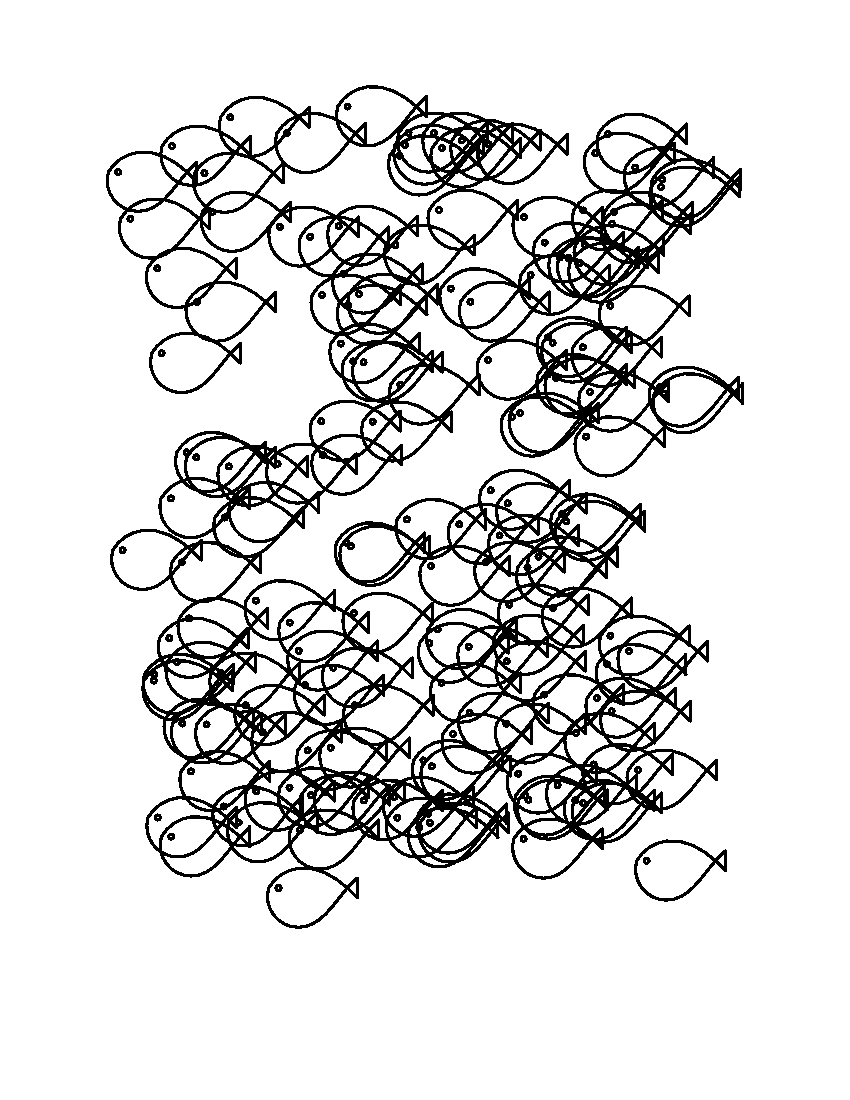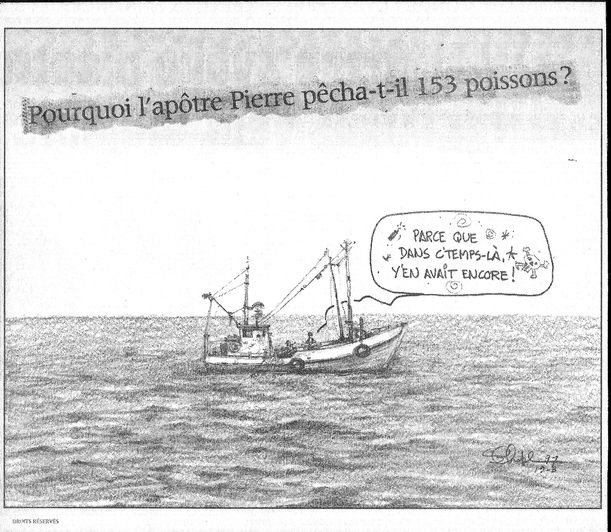The 153 big fishes
 How
would 153 big fishes look like if drawn randomly in a small rectangle?
I wondered for a few days and decided to write a Metafont program to
do just that. The result is not visually very surprising but it is
nice enough to appear on this page and serves as an introduction to an
old and odd symbolic enigma: the 153 big fishes of Chapter 21 of the
Gospel of John. The skeptics would name it "The fourth Gospel". What
is this thing all about? First, let us give the most relevant verse:
How
would 153 big fishes look like if drawn randomly in a small rectangle?
I wondered for a few days and decided to write a Metafont program to
do just that. The result is not visually very surprising but it is
nice enough to appear on this page and serves as an introduction to an
old and odd symbolic enigma: the 153 big fishes of Chapter 21 of the
Gospel of John. The skeptics would name it "The fourth Gospel". What
is this thing all about? First, let us give the most relevant verse:
So Simon Peter went aboard and hauled the net ashore, full of large fish, a hundred and fifty and three:
and for all there were so many, yet was not the net broken. (John 21:11)
The number 153 has some unique arithmetic properties. It is a
triangular number: it is the sum of the integers from 1 to 17. Almost
every modern biblical commentary on the symbolism of 153 mentions this
fact. (It is also one of the Armstrong numbers. That is, the sum
of the cubes of 1, 5, and 3 is 153. But we are really diverging.)
Would a first or second century reader of the Gospel notice this
fact? I doubt it. The meaning of it should be related to the biblical
knowledge of most readers of the Gospel, a reader that would have
started from the beginning of the Fourth Gospel and readily understood
its first chapter which recast the text of Genesis, the first book of
the Old Testament. Such a reader would be familiar with the Old
Testament.
Therefore, this is where we should seek the symbolic meaning of
the number 153.
The number 153 occurs only once in the Old Testament. Actually, it
is the number 153000, which was the number of constructors of
the first temple when Solomon was king. The number is not precise, one
reading gives 153600, another the value 153200, etc. But it is always around
153000.
But how do we explain the 1000 in 153000? This is what the
evangelist means by "big fishes". He certainly could not make you
believe that the miraculous catch was 153 thousand fishes. That would
have been not only miraculous, but beyond believable. The symbolic trick
is to use "big" to mean "1000" as a multiplier. And that actually is a
double-trick: 1000 is well known in the Old Testament to represent a
symbolic large value that cannot be counted. So, not only does the 153
big fishes refer to the 153000 constructors of the first temple, it
also means "a very large unknown number". This is also coherent
with the first observation of one of the apostles when looking inside
the net: there was a multitude of fishes.
But why the first temple of Solomon? The (first or second century)
Jewish reader was certainly interested to know if another temple
should be built. Most likely, the second temple was destroyed (70AD)
when chapter 21 was written (which is often dated around 125AD). An
attempt at rebuilding the temple occurred several times after its
destruction in 70AD. For example, such an attempt occurred in 132AD. It
is most likely that the community around the Fourth Gospel raised the
question of rebuilding a temple.
This last chapter would answer this question:
The temple is no longer a concrete building, but the community of believers
that Peter would gather.
Serge Chapleau, a well-known cartoonistin Quebec, Canada, was one day inspired by this enigma.
Not that he had any deep symbolic meaning to convey, but he took some amusement at the question and
draw up a more relevant explanation for our time: the lack of fish
near newfoundland (Canada).
But, after all, the reader is the last person to decide on the meaning
of the 153 fishes.
 Why did the apostle Peter catch 153 fishes?
Because, in those days there was some left.
Why did the apostle Peter catch 153 fishes?
Because, in those days there was some left.
 How
would 153 big fishes look like if drawn randomly in a small rectangle?
I wondered for a few days and decided to write a Metafont program to
do just that. The result is not visually very surprising but it is
nice enough to appear on this page and serves as an introduction to an
old and odd symbolic enigma: the 153 big fishes of Chapter 21 of the
Gospel of John. The skeptics would name it "The fourth Gospel". What
is this thing all about? First, let us give the most relevant verse:
How
would 153 big fishes look like if drawn randomly in a small rectangle?
I wondered for a few days and decided to write a Metafont program to
do just that. The result is not visually very surprising but it is
nice enough to appear on this page and serves as an introduction to an
old and odd symbolic enigma: the 153 big fishes of Chapter 21 of the
Gospel of John. The skeptics would name it "The fourth Gospel". What
is this thing all about? First, let us give the most relevant verse:
